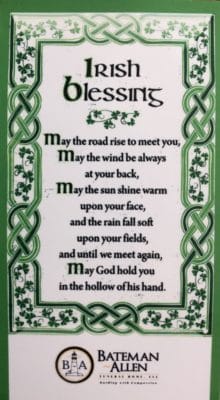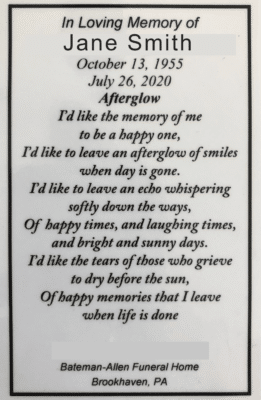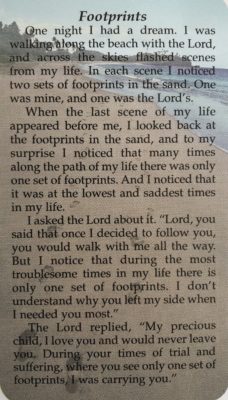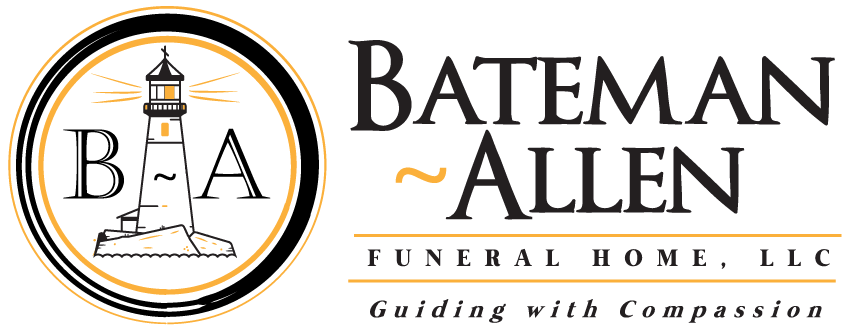
In the Christian tradition, prayer cards (also known as holy cards or memorial cards) have been a symbol of faith and community for centuries. Typically, prayer cards are small, devotional pictures mass-produced for the use of religious events such as funerals. On the front, they usually depict a religious scene or a saint in the image and are about the size of a playing card. The back typically contains a prayer that practitioners can use as a devotional aid in their event and everyday lives.
At Bateman-Allen Funeral Home, we develop prayer cards for the families we serve that depict everything from traditional saints to custom photography. It’s an important step for our clients to choose the image and prayer that perfectly illustrates the life that their loved one lived, including their values and personality.
Today, we want to help you pick the perfect prayer for your loved one’s prayer cards. Below are our top 7 most popular prayers selected by our families for prayer cards. But first, let’s talk a little about the history of prayer cards so we can appreciate their importance.
History of Prayer Cards
Prayer cards first appeared in the 1500s. These cards, which were created to be carried around or displayed in someone’s home, allowed everyday people to bring saints and religious figures into their every day lives to establish a personal connection that was previously only attainable for the rich. Most religious imagery at the time was expensive and out of reach from the majority of devout Catholics. Prayer cards were inexpensive and disposable, bringing saints and prayers to the masses in a tangible, simple way.
After centuries of improved printing strategies, prayer cards are more abundant now than ever before, giving a tangible token to many kinds of religious events. Today, many prayer cards don’t even contain a religious image, especially with commemorative or memorial cards which sometimes include a photo of the person being honored. This personalizes the cards while giving loved ones a lasting connection with the loved one that passed.
Our Top 7 Prayer Card Prayers
At Bateman-Allen Funeral Home, we’ve had the honor to help countless families in their journey to find the perfect prayer card for their loved one’s memorial or service. Below are some of our favorites.
The Irish Blessing
May the road rise up to meet you.
May the wind be always at your back.
May the sun shine warm upon your face;
the rains fall soft upon your fields and until we meet again,
may God hold you in the palm of His hand.
Originally written in the Irish language, the prayer – the author is unknown – has three main images, namely wind, sun, and rain. Fittingly for something written so long ago, the ancient Irish’s deep connection to nature and Ireland’s ever-changing elements shine through.
The reference to the wind is thought to be a reference to the Holy Spirit, who came as a “mighty wind” at Pentecost.
The sun’s warmth alludes to God’s Mercy which the New Testament (Luke 1:78, NIV) tells us “by which the rising sun will come to us from heaven.”
The mention of rain is thought to be symbolic of God’s provision – nothing will grow without the rain.
It’s a beautiful, and popular, option for many families, especially Irish Catholic in culture.

The Lord’s Prayer
Our Father, who art in heaven,
hallowed be thy name;
thy kingdom come,
thy will be done
on earth as it is in heaven.
Give us this day our daily bread,
and forgive us our trespasses,
as we forgive those who trespass against us;
and lead us not into temptation,
but deliver us from evil.
There are a few different versions of the Lord’s Prayer, also called the Our Father. Initial words on the topic from the Catechism of the Catholic Church teach that it “is truly the summary of the whole gospel“
The prayer is used by most Christian churches in their worship; with few exceptions, the liturgical form is the Matthean. Although theological differences and various modes of worship divide Christians, according to Fuller Seminary professor Clayton Schmit, “there is a sense of solidarity in knowing that Christians around the globe are praying together … and these words always unite us.” [1]
St. Augustine gives the following analysis of the Lord’s Prayer, which elaborates on Jesus’ words just before it in Matthew’s gospel: “Your Father knows what you need before you ask him. Pray then in this way” (Mt. 6:8-9):[2]
We need to use words (when we pray) so that we may remind ourselves to consider carefully what we are asking, not so that we may think we can instruct the Lord or prevail on him. When we say: “Hallowed be your name,” we are reminding ourselves to desire that his name, which in fact is always holy, should also be considered holy among men. …But this is a help for men, not for God. …And as for our saying: “Your kingdom come,” it will surely come whether we will it or not. But we are stirring up our desires for the kingdom so that it can come to us and we can deserve to reign there. …When we say: “Deliver us from evil,” we are reminding ourselves to reflect on the fact that we do not yet enjoy the state of blessedness in which we shall suffer no evil. …It was very appropriate that all these truths should be entrusted to us to remember in these very words. Whatever be the other words we may prefer to say (words which the one praying chooses so that his disposition may become clearer to himself or which he simply adopts so that his disposition may be intensified), we say nothing that is not contained in the Lord’s Prayer, provided of course we are praying in a correct and proper way.
23rd Psalm: The Lord is My Shepard
The Lord is my shepherd; I shall not want.
He maketh me to lie down in green pastures: he leadeth me beside the still waters.
He restoreth my soul: he leadeth me in the paths of righteousness for his name’s sake.
Yea, though I walk through the valley of the shadow of death, I will fear no evil: for thou art with me; thy rod and thy staff they comfort me.
Thou preparest a table before me in the presence of mine enemies: thou anointest my head with oil; my cup runneth over.
Surely goodness and mercy shall follow me all the days of my life: and I will dwell in the house of the Lord for ever.
Psalm 23 is the 23rd psalm of the Book of Psalms, generally known in English by its first verse, in the King James Version, “The Lord is my Shepherd”.
Like many psalms, Psalm 23 is used in both Jewish and Christian liturgies. It has been set to music often. It has been called the best-known of the psalms for its universal theme of trust in God.[3]
The theme of God as a shepherd was common in ancient Israel and Mesopotamia. For example, King Hammurabi, in the conclusion to his famous legal code, wrote: “I am the shepherd who brings well-being and abundant prosperity; my rule is just…. so that the strong might not oppress the weak, and that even the orphan and the widow might be treated with justice.”[4]] This imagery and language was well known to the community that created the Psalm, and was easily imported into its worship.

Afterglow
I’d like the memory of me to be a happy one.
I’d like to leave an afterglow of smiles when life is done.
I’d like to leave an echo whispering softly down the ways,
Of happy times and laughing times and bright and sunny days.
I’d like the tears of those who grieve, to dry before the sun;
Of happy memories that I leave when life is done.
Afterglow is a short funeral poem by Helen Lowrie Marshall about happy memories living on after a loved one has gone. It’s a beautiful way to support those that are grieving.
John 14
Let not your hearts be troubled. Believe in God. believe also in me. In my Father’s house are many rooms. If it were not so, would I have told you that I go to prepare a place for you? And if I go and prepare a place for you, I will come again and will take you to myself, that where I am you may be also. And you know the way to where I am going.”
John 14 is the fourteenth chapter of the Gospel of John in the New Testament of the Christian Bible. It continues Jesus‘ discussions with His disciples in anticipation of His death and records the promised gift of the Holy Spirit.[1] Jesus speaks individually with Thomas, Philip, and Judas (not the Iscariot). The book containing this chapter is anonymous, but early Christian tradition uniformly affirmed that John composed this Gospel.[5]
Do Not Stand at My Grave and Weep
Do not stand at my grave and weep
I am not there; I do not sleep.
I am a thousand winds that blow,
I am the diamond glints on snow,
I am the sun on ripened grain,
I am the gentle autumn rain.
When you awaken in the morning’s hush,
I am the swift uplifting rush
Of quiet birds in circled flight.
I am the soft stars that shine at night.
Do not stand at my grave and cry,
I am not there; I did not die.
There have been many claimants to the poem’s authorship, including attributions to traditional and Native American origins. Dear Abby author Abigail Van Buren researched the poem’s history and concluded in 1998 that Mary Elizabeth Frye, who was living in Baltimore at the time, had written the poem in 1932. According to Van Buren’s research, Frye had never written any poetry, but the plight of a German Jewish woman, Margaret Schwarzkopf, who was staying with her and her husband, had inspired the poem.
Margaret Schwarzkopf was concerned about her mother, who was ill in Germany, but she had been warned not to return home because of increasing unrest. When her mother died, the heartbroken young woman told Frye that she never had the chance to “stand by my mother’s grave and shed a tear”. Frye, according to Van Buren’s research, found herself composing a piece of verse on a brown paper shopping bag. Later she said that the words “just came to her” and expressed what she felt about life and death.[6]
The Footprints
One night I dreamed a dream.
As I was walking along the beach with my Lord.
Across the dark sky flashed scenes from my life.
For each scene, I noticed two sets of footprints in the sand,
One belonging to me and one to my Lord.
After the last scene of my life flashed before me,
I looked back at the footprints in the sand.
I noticed that at many times along the path of my life,
especially at the very lowest and saddest times,
there was only one set of footprints.
This really troubled me, so I asked the Lord about it.
“Lord, you said once I decided to follow you,
You’d walk with me all the way.
But I noticed that during the saddest and most troublesome times of my life,
there was only one set of footprints.
I don’t understand why, when I needed You the most, You would leave me.”
He whispered, “My precious child, I love you and will never leave you
Never, ever, during your trials and testings.
When you saw only one set of footprints,
It was then that I carried you.”
“Footprints,” also known as “Footprints in the Sand,” is a popular allegorical religious poem. It describes a person who sees two pairs of footprints in the sand, one of which belonged to God and another to him or herself. At some points the two pairs of footprints dwindle to one; it is explained that this is where God carried the protagonist.
This popular text is based in Christian beliefs and describes an experience in which a person is walking on a beach with God. They leave two sets of footprints in the sand. The tracks represent stages of the speaker’s life. The two trails dwindle to one, especially at the lowest and most hopeless moments of the person’s life. When questioning God, believing that the Lord must have abandoned his love during those times, God gives the explanation, “During your times of trial and suffering, when you see only one set of footprints, it was then that I carried you.”

Those are our favorite most popular prayer card prayers. To learn more about our prayer cards and funeral options, click here!
Resources:
[1] Kang, K. Connie. “Across the globe, Christians are united by Lord’s Prayer.” Los Angeles Times, in Houston Chronicle, p. A13, April 8, 2007.
[2] “From a letter to Proba by Saint Augustine, bishop (Ep. 130, 11, 21-12, 22: CSEL 44, 63-64) On the Lord’s Prayer”. adoration. 2015-10-20. Retrieved 2020-07-16.
[3] Heller, Rebbetzin Tziporah (3 August 2002). “The Lord is My Shepherd”. Aish.com. Retrieved 28 June 2018.
[4] “Hammurabi’s Code, circa 1780BC”. history.hanover.edu. Retrieved 2017-12-12.
[5] Holman Illustrated Bible Handbook. Holman Bible Publishers, Nashville, Tennessee. 2012.
[6] “Mary E. Frye”. The Times. London, United Kingdom. 5 November 2004. Retrieved May 8, 2011.



Recent Comments